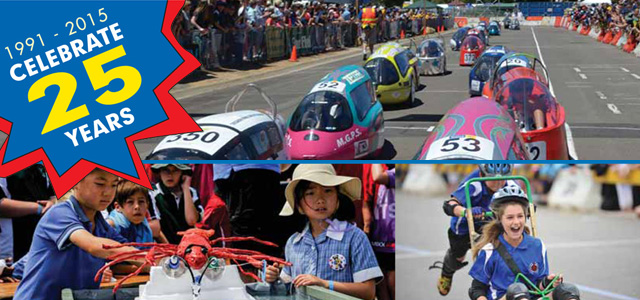
The 2015 School’s Handbook is now available to download and is your comprehensive guide to this year’s RACV Energy Breakthrough. Visit the Downloads page now to get your copy >
The big news:
- EEVs will re-join the secondary HPV teams on an extended RACV Track.
- Pushcarts get a revamped scheduled; and
- Primary HPV teams can have up to 10 riders.
As we flagged earlier this week, the RACV Energy Breakthrough Executive Committee, have been working together on a number of new ideas for this year’s event. Read that post here >
Firstly, these changes form stage one of a three-stage plan. The next two stages promise more event capacity where demand is strongest and to improve the experience for visitors and spectators.
We wanted to make sure we had all of these big changes in place before entries opened. Of course, we would have preferred for this information to be ready for you earlier, but we only received some of the required approvals this week.
So, here’s a rundown on those three big changes and why they’ve been made:
Big Change #1: The Energy Efficient Vehicles will re-join the Secondary Human Powered Vehicle teams on an extended RACV Track.
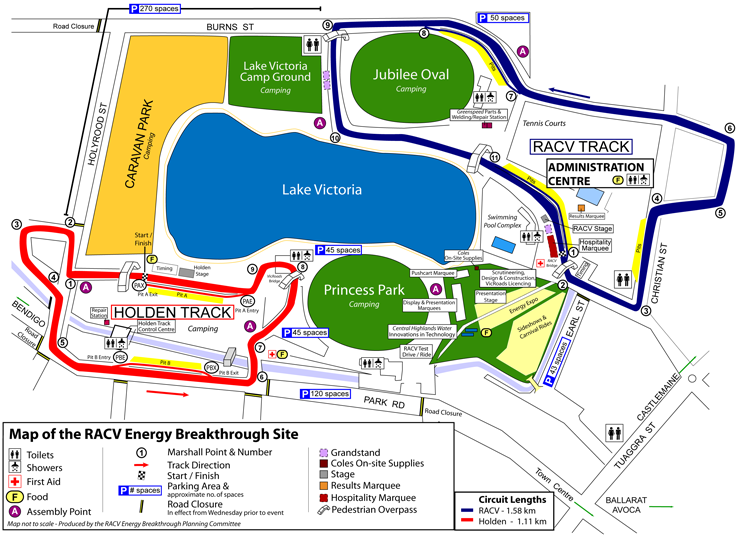
What will the new section of RACV track be like?
View map >
The new section will add 235 metres and bring the total length of the track to 1,575 metres. This is the first significant modification to the RACV Track ever. It’s not billiard table smooth and reflects real world conditions.
As they climb up the hill, riders will take a right hand turn off Christian St, after ALDI, followed quickly by a left-hander leading into the uphill Crameri Lane.
As riders reach the top, they’ll take a sharp left onto Burns St (commonly known as the ‘back straight’). From here they’ll rejoin the traditional RACV Track.
Why the change?
Safety
We have held significant safety concerns with the Try-athlon Primary Class participating on the Holden Track alongside the Energy Efficient Vehicles (EEVs) under their previous arrangements.
The Try-athlon is often entered by new schools, and often inexperienced primary school students and junior secondary students are involved (which is great, by the way). However, the EEV event attracts experienced middle and upper secondary students who often want to travel fast. This is not an optimal combination.
We believe that the mix of Secondary HPVs and EEVs on an expanded RACV Track is more appropriate and safe.
One of the concerns surrounding the EEV’s sharing the track with other vehicles is their weight and with this in mind we have incentivised the reduction of weight by including it as a portion of the Design and Construction score from 2015 onwards.
We have also excluded two seater vehicles from the event from 2015 onwards as we believe these increase congestion.
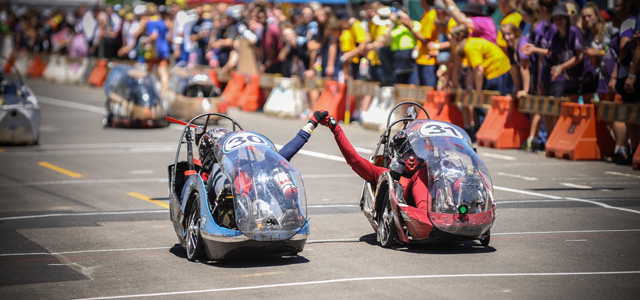
EEV Numbers
The HPV and Try-athlon categories for the Energy Breakthrough have been at capacity for several years with waiting lists in place in many categories. Entries each year for the EEV category, however, have remained between 20 and 30.
We love the EEVs – they speak to the core of the ‘Energy Breakthrough spirit’ and are really at the pointy end of energy efficiency – BUT the reality is that it is very difficult to justify operating a track for 16 or 24 hours for so few teams.
Reduced track time, better marshaling
The reduction in track time will help us better respond to the marshaling demands across the event. Marshaling was a hot topic after the 2014 event and there’ll be revised and improved Marshall training, developed in collaboration with and through the support of other events.
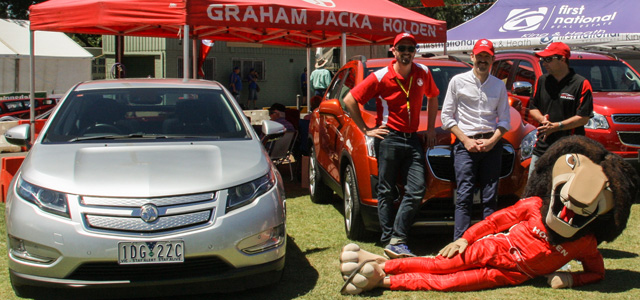
Responding to industry direction: electric
The automotive industry appears to be focusing more on electric drivetrains through pure electric vehicles and (plug-in) hybrids. (Like the Holden Volt pictured above left, for instance)
There are several companies in Australia offering eBike conversion kits that can be adapted to a HPV with relative ease.
These kits do not significantly increase the weight of the vehicle.
Allowing for future growth of Try-athlon
The Try-athlon category began life as a spin-off event for teams on the HPV Waiting List. It now has a dedicated following and we believe that in the future (not necessarily in 2015) this category will grow as well.
Big Change #2: The Pushcart Schedule has been completely redeveloped
Why the changes?
To improve the experience for students and teachers, reduce waiting times for events and improve the connection to other categories.
What are the changes?
The Design & Construction and Scrutineering components have been combined on Thursday afternoon, requiring teams to be on-site earlier, but allowing more time for the process to take place.
The Endurance event has shifted to the Holden Track and Friday morning, which we hope will offer a better experience for students and their families, as well as reduced waiting times. This will also act as an exciting curtain raiser to the HPV A Trial and offer schools with teams in both categories to cheer their teams.
Big Change #3: Increased Participation for Primary School HPV teams
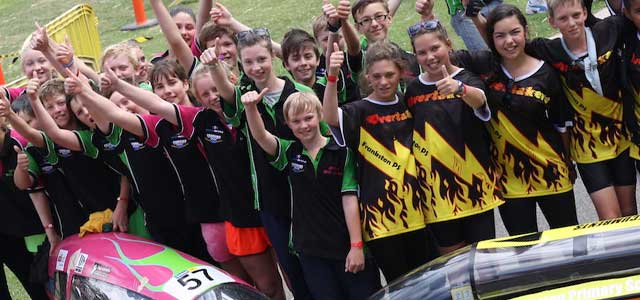
Also flagged earlier this week, Human Powered Vehicle Class A and Try-athlon Class A teams will now have the opportunity to run up to a maximum of ten riders. You’ll still have to have an even gender ratio of boys to girls too.
Why the change?
We’re well aware that the popularity of Human Powered Vehicles is booming in many Primary schools, and this is one immediate way that we can respond initially to that growth in demand.
2016 and beyond…
With these steps, the RACV Energy Breakthrough Executive Committee believe we are laying the foundation for other future developments that will help us – and you, the Energy Breakthrough community – respond to the question of ‘where to next?’
Now, don’t forget to download the 2015 School’s Handbook from our Downloads page and enter >





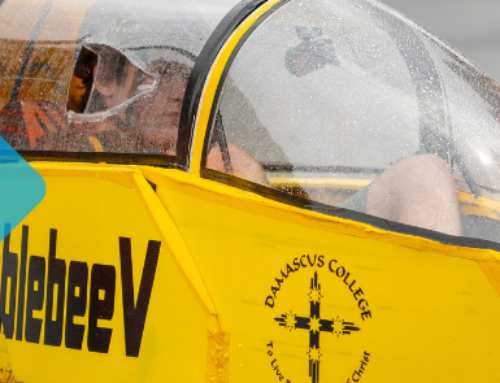

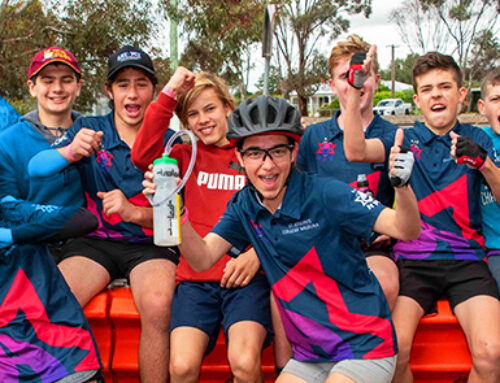
Last year was bad enough on the Track. Our trike got rolled and hit by 5 other trikes not slowing down for a yellow flag; let alone not having the EEVs on the track.
The rules should be enforced when there are accidents bikes not slowing down for yellow flags.
It will be even worse going through crash corner with EEVs this year. There were enough trikes as it was without EEVs on the track too.
Hi Josh,
A fair concern and we’re sorry that you had a rough experience last year. The addition of the EEVs along with the extension of the track will not significantly change the track density, meaning that the number of vehicles per metre won’t be significantly different either.
The marshaling and compliance issues that you’ve raised here; we are responding to with new a Marshal training package that we are developing with other events.
Ultimately though, it is also up to the individual riders to observe the rules and ride safe. Which will also be addressed during our re-established Spirit of Competition forum on the Friday afternoon of the event.
Thanks for your energy and stay tuned.
~ Nigel @ EB
Well, what sad news these changes are.
We have had our young men together this afternoon discussing the implications of these “big changes” with a level of dismay. Surely, if nothing else, it would have been fairer to phase these changes in over a year or more.
We now have three vehicles that won’t have a hope of meeting the weight requirements and the battery charging changes mean our electric vehicle wouldn’t be competitive anyway.
I’m sure the new battery charging situation will be expensive.
It seems that buying a trike from Greenspeed will be the only option for us, as the frames that we make will be too heavy and students can’t weld alloy metals to construct anything lighter. Unfortunately such a purchase is out of the question so I guess we won’t be seeing our fifteenth year in the competition.
Much of the fantastic learning about Design and Construction that has always been the greatest asset of the Energy Breakthrough will now be lost as schools are forced to purchase frames, and many low budget schools will simply be out of the running.
I can’t fathom how the EEVs can possibly compete safely with the very fast HPVs whizzing around them, or worse still banging into them, even if there is a track extension.
I understand the need to make room for more primary competitors but this makes the event a pedaling breakthrough, not an energy breakthrough.
It seems that despite declarations of love for the EEVs, who are the truly innovative vehicles, Energy Breakthrough management have decided to make life extremely difficult for EEV competitors in a bid to discourage them from the comp.
Our two teams of very eager 2015 competitors, as well as a rich history of Chairo students who thrived in preparing for Maryborough, beg you to reconsider the changes.
With these changes to all teams on the track, often EEV vehicles using petrol power will reach high speeds and have in the past used other vehicles as bumpers to get through a corner.
Reaching those sorts of speeds on the Holden track is impressive, but on the Track’s many straights, speeds from these EEV’s would easily surpass 60kmh and the bigger more solid EEV’s could wreck more havoc with higher speeds then they did on the Holden Track.
Will there be more speed monitoring around the track or will it get brushed off as unimportant?
Hi Liam,
Thanks for your comment – clearly quite passionate.
The speed limit remains unchanged at 60 km/h. The reduced number of overall track hours will allow us to respond better to the marshaling needs. Speed monitoring will be increased, as it’s clearly a concern with this new configuration, and our capacity to marshal, investigate and penalise (where appropriate) will be improved too.
We’ve always run EEVs and HPVs together. It’s just that in recent years this has been on the Holden Track with the Try-athlon teams.
Ultimately, whilst we can police teams, it’s the riders themselves who have to do the right thing.
Great to see that changes are being made in an attempt to improve the event where required, participation, marshalling, etc. I will be keen to see how rejoining the EEV’s with the secondary HPV’s on an extended track works out. It seems very reasonable given EEV numbers but I hope it’s not opening the door for their final demise. Can I suggest we use clearly differentiated number panels so spectators can distinguish the different vehicle classes on the track. ‘Incentivising’ EEV mass in design and construction is a good call too, but maybe more will have to be done in the future to reduce the mass of EEV’s for safety’s sake. Maybe some changes to the EEV rules are required.
Hi John,
Thanks for your note of support. I think the identification idea for EEVs is a good one too.
I think its great that things are trying to be done to make it a better experience for everyone, but won’t the weight of the EEVs and their speed be a big problem if one of those were to T-bone a lighter build HPV?
Also, they wear fire safety suits in case of an obvious problem with the fuel catching fire, doesn’t that mean riders of the HPVs will be at a fire risk too without the safety equipment?
I certainly don’t want to be riding around in those jump suits for over an hour in heat either.
Hi Will,
The rider’s clothing requirements remain unchanged and are designed specifically for the one in immediate danger: the rider. As a result there is no need for riders of HPVs to wear full overalls.
We’ve actually always run HPVs alongside EEVs, it’s just that in recent years they were Try-athlon teams on the Holden Track, not Secondary HPV teams. We’ve also had few major incidents between these two types of vehicles.
The roll cage regulations in place encourage a safe experience for riders, riders of other vehicles, marshals and spectators and we continue to be confident they will offer suitable protection, but it is something we constantly monitor.
I think this is a great idea, it has always been an issue having the EEVs with the younger try-athlon teams.
To address the idea that some people have that the EEVs will use speed and weight to bump through traffic, I have to say that this is just not fact and I cannot think of any team who would do this. Also EEVs are much more fragile than HPVs in some ways, there are a lot of mechanical things that can go wrong and break. The EEV race is ALWAYS won by the team with no crashes or breakdowns.
The issue of speed of the EEVs has been raised here, although I don’t think it will be a major concern, most of the EEVs will not be any faster than the highly competitive HPVs. Yes, there is a motor but we don’t use the motor on the whole track, it is used sparingly to last (3 litres for 24hrs), almost always on the straights and the motor is killed before corners.
Also there is a different way of racing in EEV, there is no importance placed on lap records and fastest laps, our race is more about endurance and making the fuel or batteries last. If you do a quick lap in EEV it means you wasted a load of fuel for one lap, not very smart.
Also the issue of weight, it is very difficult to make these vehicles lighter, however it can be done. It took us three re-builds. Many HPV competitiors many be surprised to know our Hybrid 1 is below the HPV maximum weight limit.
Agree with John Taylor different identification panels will be great for spectators but also for other teams, many EEVs can be easily mistaken for HPVs.
Can I suggest that the EEVs are keep in the same pit area? We are a big community and we on many occasions share and borrow speciality tools and parts as well as lending a hand to each other. Will be easier if we are kept all together.
I’m glad these changes have been made and am looking forward to November!
I think it will be fine.
Casey has run them together, as have other events, all to good effect. No dramas. The weight thing is fairly irrelevant on many levels. So, build a better car and aim for less weight. That’s the actual challenge facing the whole world. It might encourage a clean sheet approach for Hybrids which will improve the class yet again.
HPV’s aren’t all that light either and maybe some will revisit their tired old designs and re-assess. Maybe some teams should stop turning up with the same old cars 12 years in a row.
What this might end up doing is encouraging HPV schools to consider switching ‘over to the dark side’ and getting back to where it all began. Convert that old hpv into a hybrid and get back to the fun side. My team are already asking if we can do it. (I said no, not now).
It can be seen to parallel F1 to some degree as well, with a big shake-up last year that has reset the competition there in a big way. F1 has also seen many teams buying much of their gear from other suppliers and outfits and just racing it, just to stay in the game. This is actually acceptable for our competition too. It comes under the heading ‘liaise with industry’. I would still argue though that student designed and built is the better option and deserves more credit than it currently gets.
The decision is logical and has merit. Let’s see how it goes and reflect afterwards. Who knows, it might actually work out quite well!
I also think that it wont be an issue. As stated earlier, the EEV’s dont seem to get into the bump and grind as the HPV’s can in my experience (6 years of team management of a HPV team, 3 years managing an EEV team).
I don’t think the speed differentials will be an issue, the top HPV teams can exceed the track speed limit as well and usually cover more distance over the length of the event. As stated in an earlier post, EEV’s cant use their power sources 100% of the lap and make it to the end. Personally, my old team would use the motor for less than half of the straights only per lap, the rest was pedaling. Qualifying may be different though…
It has been noted that some EEV teams are concerned with the 60kg weight limit. My old EEV weighed in at 61.3kg ready to race – fuel, batteries inc. This trike was not anything special, CrMo tubing and coreflute and included extra bars in the roll cage structure that were not required in the regulations. It was 100% constructed by the school with nothing more exotic than a mig welder.
A close look at the weights from the 2012 (?) event show that there are HPV’s heavier than that.
The only issue I have is the entry quota. Are the EEV’s going to be included in the 3 teams per school limit or has this rule been removed. If not, there are teams that run EEV’s that also enter 3 HPV’s as well.